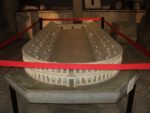 You may or may not have learned that the Roman Baroque masterpiece now known as Piazza Navona started out as a stadium built by the Emperor Domitian (81-96 A.D.) in 86 A.D. to celebrate the Certamen Capitolino Iovi, a musical, theatrical and athletic performance dedicated to Jupiter. He modeled the new stadium and the accompanying odeon on the Greek model, but Domitian didn’t simply use the terrain of a natural hill to build the multi-tiered stands into the way the Greeks did with their stadia. He had the financial means, the labour and the technology to create everything from scratch, and boy did he. The site he selected was on the Campus Martius, a level field outside the ancient Servian Wall that had served for centuries as a military training ground when Roman law prohibited the presence of troops inside the official boundary of the city.
You may or may not have learned that the Roman Baroque masterpiece now known as Piazza Navona started out as a stadium built by the Emperor Domitian (81-96 A.D.) in 86 A.D. to celebrate the Certamen Capitolino Iovi, a musical, theatrical and athletic performance dedicated to Jupiter. He modeled the new stadium and the accompanying odeon on the Greek model, but Domitian didn’t simply use the terrain of a natural hill to build the multi-tiered stands into the way the Greeks did with their stadia. He had the financial means, the labour and the technology to create everything from scratch, and boy did he. The site he selected was on the Campus Martius, a level field outside the ancient Servian Wall that had served for centuries as a military training ground when Roman law prohibited the presence of troops inside the official boundary of the city.
 Measuring about 275 meters long and 106 meters wide (902 x 348 feet), the stadium had one curved end and one flat end with two long parallel sides. The entrances were in the middle of the curved end (the hemicycle) and the long sides and, like all Roman stadia, had meticulously arranged numbered archways and staircases for optimal traffic flow and access to the bleachers. Archaeologists estimate that it could seat around 30,000 people.
Measuring about 275 meters long and 106 meters wide (902 x 348 feet), the stadium had one curved end and one flat end with two long parallel sides. The entrances were in the middle of the curved end (the hemicycle) and the long sides and, like all Roman stadia, had meticulously arranged numbered archways and staircases for optimal traffic flow and access to the bleachers. Archaeologists estimate that it could seat around 30,000 people.
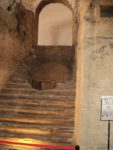 It was used temporarily to host gladiatorial games after a fire disabled the Colosseum in 217 A.D., and some years later it was restored by the Emperor Alexander Severus. We know it was still in use in the 4th century because the historian Amianus Marcellinus mentions it. Shortly thereafter it was abandoned and suffered the same fate as the Circus Maximus, Colosseum and other monumental feats of Roman architecture: it was used as a quarry to supply travertine and brick for new construction. As its building materials were stripped away, its entrances and arches were used as shops and stables.
It was used temporarily to host gladiatorial games after a fire disabled the Colosseum in 217 A.D., and some years later it was restored by the Emperor Alexander Severus. We know it was still in use in the 4th century because the historian Amianus Marcellinus mentions it. Shortly thereafter it was abandoned and suffered the same fate as the Circus Maximus, Colosseum and other monumental feats of Roman architecture: it was used as a quarry to supply travertine and brick for new construction. As its building materials were stripped away, its entrances and arches were used as shops and stables.
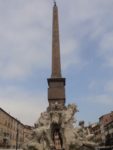 Within three centuries of Marcellinus’ writing, Romans had already forgotten the very name of the stadium, calling it the Circus Flamineus, then the Circus Alexandri, then the Campus Agonis which was corrupted into Navoni and ultimately Navona, which happens to mean big ship. The coincidence of this linguistic evolution led to the birth of the urban legend that the Piazza Navona was named after the naumachia, sea battles staged in an artificial lake inside the Circus. This never happened. It wasn’t that kind of arena.
Within three centuries of Marcellinus’ writing, Romans had already forgotten the very name of the stadium, calling it the Circus Flamineus, then the Circus Alexandri, then the Campus Agonis which was corrupted into Navoni and ultimately Navona, which happens to mean big ship. The coincidence of this linguistic evolution led to the birth of the urban legend that the Piazza Navona was named after the naumachia, sea battles staged in an artificial lake inside the Circus. This never happened. It wasn’t that kind of arena.
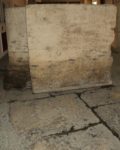 Once the Piazza Navona was built, following precisely the shape of its ancient progenitor (which had been extensively built upon by that point), THEN it was flooded. Roman nobles got a big kick out of racing their carriages, some built in the shape of fantastical sea monsters but still pulled by regular terrestrial horses, poor things, through the flooded piazza every year.
Once the Piazza Navona was built, following precisely the shape of its ancient progenitor (which had been extensively built upon by that point), THEN it was flooded. Roman nobles got a big kick out of racing their carriages, some built in the shape of fantastical sea monsters but still pulled by regular terrestrial horses, poor things, through the flooded piazza every year.
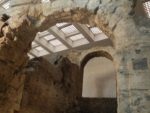 With all the despoliation of Domitian’s original structure, including the regular bouts of construction on top of and in the middle of whatever was left, it’s remarkable that any of it was left to rediscover in 1936 when Mussolini’s project to demolish, rebuild and modernize the area’s streets and houses ran into the remains of the cavea, including a large travertine-clad entrance arch from the hemicycle end. A few bits and pieces were known to have survived in the basements of some of the houses along the piazza and under the Church of St. Agnes, but the discoveries from the 30s were more extensive and complete.
With all the despoliation of Domitian’s original structure, including the regular bouts of construction on top of and in the middle of whatever was left, it’s remarkable that any of it was left to rediscover in 1936 when Mussolini’s project to demolish, rebuild and modernize the area’s streets and houses ran into the remains of the cavea, including a large travertine-clad entrance arch from the hemicycle end. A few bits and pieces were known to have survived in the basements of some of the houses along the piazza and under the Church of St. Agnes, but the discoveries from the 30s were more extensive and complete.
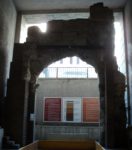 Still, nobody gave much of a damn about them. When I was a kid growing up in Rome in the 80s, you could see exactly one part of Domitian’s Stadium from the street, the big entrance arch, and because ground level was so much higher than it had been in imperial times, you really had to look for it at ankle height. That finally changed in 2014 when a new archaeological area opened underneath the Piazza. It is a small, eminently manageable, phenomenally well-lit museum featuring large chunks of Domitian’s Stadium and a handful of statue fragments, inscriptions and building materials discovered during the dig. I didn’t even know it was there until I happened to walk by the sign and followed it like the yellow brick history nerd road it is, and I read about this kind of thing every day. It’s crazy that it’s so little known. It is the only surviving example of a masonry-built stadium outside of the Greek world. People should be freaking out about it.
Still, nobody gave much of a damn about them. When I was a kid growing up in Rome in the 80s, you could see exactly one part of Domitian’s Stadium from the street, the big entrance arch, and because ground level was so much higher than it had been in imperial times, you really had to look for it at ankle height. That finally changed in 2014 when a new archaeological area opened underneath the Piazza. It is a small, eminently manageable, phenomenally well-lit museum featuring large chunks of Domitian’s Stadium and a handful of statue fragments, inscriptions and building materials discovered during the dig. I didn’t even know it was there until I happened to walk by the sign and followed it like the yellow brick history nerd road it is, and I read about this kind of thing every day. It’s crazy that it’s so little known. It is the only surviving example of a masonry-built stadium outside of the Greek world. People should be freaking out about it.
I mean, the rest rooms alone are worth the price of admission:
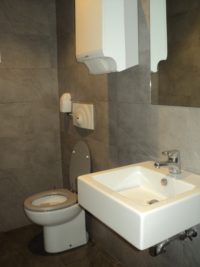
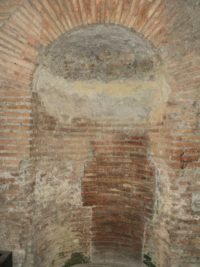
Pity that I never made it to Rome.
Of course, I knew that there was ‘Piazza Navona’ and ‘Campus Martius’, but currently I was indeed unaware of the ‘stadium’. However, I have e.g. been to ‘Eastern Rome’ -aka ‘Lygos’ aka ‘Byzantion’ aka ‘Νέα Ῥώμη’ aka ‘Konstantinopolis’ aka ‘Istanbul’- and the remains of a ‘circus’ there:
The ‘Sultan Ahmet Square’, former ‘Hippodrome’ (Ἱππόδρομος τῆς Κωνσταντινουπόλεως), likewise with remains of the original structure (they have a ‘Serpent Column’ and two ‘Obelisks’, one of them ‘genuine’, i.e. back then ‘imported’ from Egypt, and one can still recognize the ‘shape’ of the ‘hippodrome’).
:hattip:
——————–
“The term “deme” (dēmos/ δῆμος) survived into the Hellenistic and Roman eras. The term was used to refer to one of the four chariot racing factions, the Reds, the Blues, the Greens and the Whites. They combined aspects of street gangs and political parties [the ‘Nika’ riots of 532 notably resulted in 30000 casualties] In modern Greece, the term dēmos is used to denote the municipalities [cf. ‘Democracy’].”
However, the fair tradition is kept alive: Current ‘sport factions’, dating back from the 15th century, are found in the ‘Palio di Siena’ (horse racing – yes, in Siena) or the rather violent ‘Calcio Storico’ (‘soccer’ – sort of) in Florence.
Very interesting!
I’ve seen the arch pictured i photo # 7 from the street but it looks like I have yet another small museum to visit next time we’re in Rome. :boogie:
You’ve called it “Diocletian’s stadium” in the title, rather than Domitian’s! May want to fix.